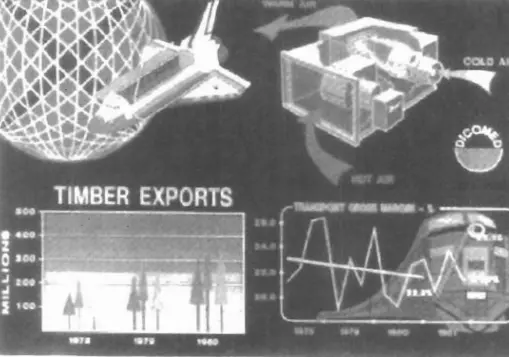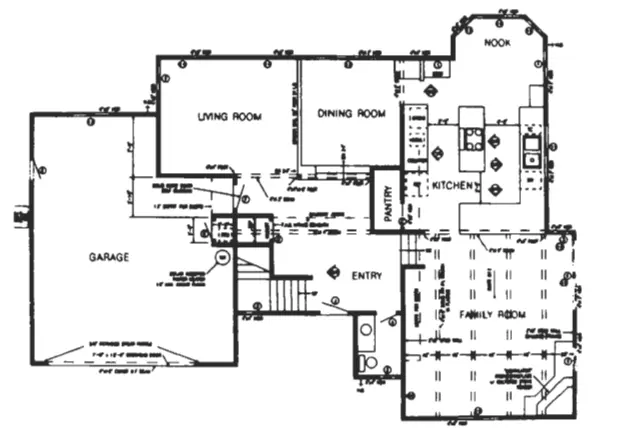
Computers have revolutionized the way we produce pictures, making them faster and more cost-effective. Nowadays, graphical displays are widely used in almost every field, making computer graphics an indispensable tool.
Earlier, using computer graphics required expensive and bulky equipment. However, with advancements in technology, interactive computer graphics have become more practical.
We now see computer graphics being used in various fields, including science, engineering, medicine, business, industry, government, art, entertainment, advertising, education, and training. Figure 1 summarizes the many applications of graphics in simulations, education, and graph presentations. Before delving into the details of computer graphics, let us take a brief tour of a gallery of graphics applications.

Computer-aided design
Computer graphics have become an integral part of the design process, particularly for engineering and architectural systems. Computer-aided design (CAD) methods are widely used in the design of various products, including buildings, automobiles, aircraft, and even textiles.
For some design applications, objects are displayed in wireframe outline form, which enables designers to see the effects of interactive adjustments to design shapes quickly. CAD software packages provide designers with a multi-window environment that can show enlarged sections or different views of objects.
Standard shapes are often supplied for electrical, electronic, and logic circuits, allowing the designer to create personalized symbols for constructing networks or circuits. The graphics package automatically provides connections between components, allowing the designer to quickly try out alternate circuit schematics.

Presentation graphics
Presentation graphics is another major application of computer graphics used for producing illustrations for reports or generating slides or transparencies for use with projectors.
It is commonly used to summarize financial, statistical, mathematical, scientific, and economic data for various types of reports. Workstation devices and service bureaus exist for converting screen displays into 35-mm slides or overhead transparencies for use in presentations.
Examples of presentation graphics include bar charts, line graphs, surface graphs, pie charts, and other displays showing relationships between multiple parameters. Three-dimensional graphs can also be used to provide a more dramatic or attractive presentation of data relationships. Examples of 3D graphics include surface plots and contour plots. Overall, presentation graphics allow for effective and visually appealing presentations of data.
Computer Art
Computer graphics techniques are widely used in the fields of fine art and commercial art. Various computer methods are utilized by artists, such as specialized hardware, paintbrush programs like Lumens, paint packages such as Pixelpaint and Superpaint, specific software, symbolic mathematical packages, CAD packages, desktop publishing software, and animation packages. These tools provide artists with the ability to design object shapes and movements.
Entertainment
Nowadays, computer graphics techniques are extensively utilized in the production of motion pictures, music videos, and television shows. In some cases, graphic scenes are displayed independently, whereas, in others, graphic objects are merged with the actors and live scenes to create an immersive visual experience for the audience.
These graphics can range from basic animations to highly complex visual effects that involve advanced simulations and 3D modeling techniques. The use of computer graphics in media production has revolutionized the way visual effects are created and has opened up new possibilities for creative expression in the entertainment industry.
Education and Training
Computer-generated models are often used as educational aids to help trainees understand the operation of physical, financial, and economic systems. Simulators are designed for practice sessions or training of ship captains, aircraft pilots, heavy-equipment operators, and air traffic control personnel. Some simulators provide graphics screens for visual operation, while others have no video screens, such as a flight simulator with only a control panel for instrument flying.
Multiple panels viewing screens with color projectors are used to display the flight path in front of the simulator. Instructors use the keyboard to input parameters affecting the airplane performance or the environment, and the pen plotter is used to chart the path of the aircraft during a training session.
Visualization
Scientists, engineers, medical professionals, and others often need to analyze large amounts of data or study complex processes. Supercomputers are used to perform numerical simulations, which can produce data files containing thousands or even millions of values. However, interpreting such data sets can be a tedious and ineffective process.
To make the trends and patterns more easily visible, the data can be converted into visual forms. This process is known as scientific visualization. Business visualization, on the other hand, deals with data sets related to commerce, industry, and other non-scientific areas.
Different kinds of data sets require different visualization techniques, such as color coding, contour plots, graphs, surface renderings, and visualizations of volume interiors. Image processing techniques are often combined with computer graphics to produce effective data visualizations.
Image processing
Computer graphics and image processing are two related but different fields. Computer graphics is used to create new images on a computer, while image processing modifies existing images to improve quality or extract information. Image processing has two primary applications: improving picture quality and machine perception of visual information, such as in robotics.
First, an image is digitized into a file, and then digital methods are used to enhance color, adjust shading, or rearrange picture parts. For example, image processing can be used to retouch and rearrange sections of photographs and other artwork. These techniques are also used to analyze satellite photos of the Earth and galaxies.
GRAPHICAL USER INTERFACES
Nowadays, it is very common for software packages to come equipped with a graphical interface. This interface is usually composed of a window manager that enables the user to display multiple-window areas, with each window containing a different process that can have graphical or non-graphical displays. By simply clicking on a window using an interactive pointing device, that window can become active. The interface also features menus and icons for quickly selecting processing options or parameter values. Icons are graphical symbols designed to resemble the processing option they represent, and menus consist of lists of textual descriptions and icons.
FAQs
What is computer graphics?
Computer graphics is the field of study that deals with the creation, manipulation, and display of images using computers.
What are the different types of computer graphics?
There are two main types of computer graphics: raster graphics (also known as bitmap graphics) and vector graphics.
What are raster graphics?
Raster graphics are images made up of pixels, which are tiny colored squares. They are used for photographs, digital artwork, and other complex images.
What are vector graphics?
Vector graphics are images made up of mathematical formulas that describe lines, curves, and other shapes. They are used for logos, fonts, and other simple images.
What are the applications of computer graphics?
Computer graphics are used in a wide range of applications, including video games, movies, TV shows, medical imaging, engineering, architecture, and more.
What is 3D computer graphics?
3D computer graphics is the creation of three-dimensional images and animations using computers. They are used in video games, movies, and other applications.
What are some popular 3D modeling software?
Some popular 3D modeling software includes Autodesk Maya, 3ds Max, Blender, and Cinema 4D.
What are shaders?
Shaders are programs that run on graphics processing units (GPUs) and are used to create special effects in 3D computer graphics.
What is rendering?
Rendering is the process of creating a final image from a 3D model using lighting, textures, and other effects.
What is virtual reality?
Virtual reality is a computer-generated environment that simulates a real or imaginary world. It is typically experienced through a headset or other specialized equipment.

2 thoughts on “Computer Graphics and its Application”